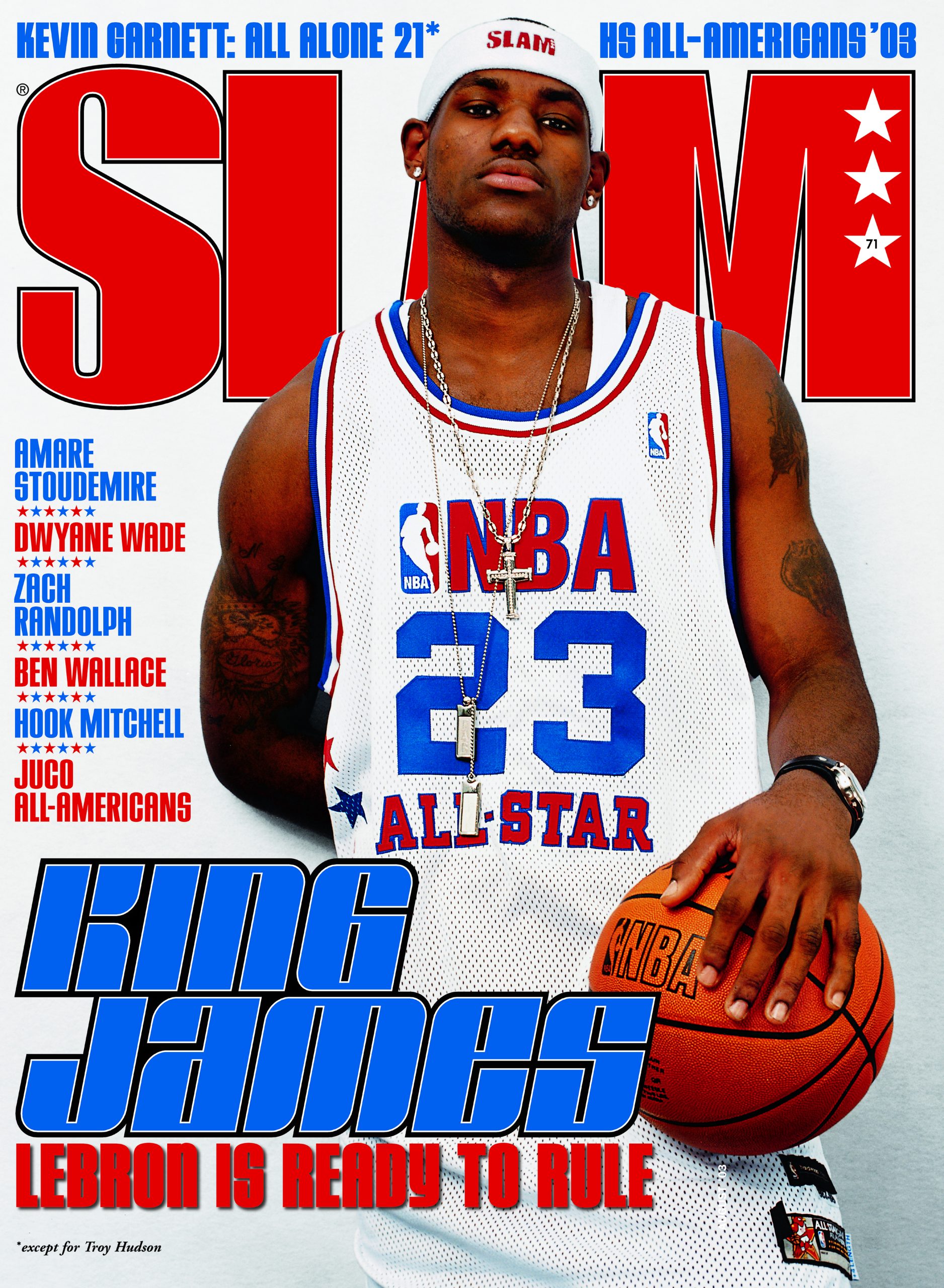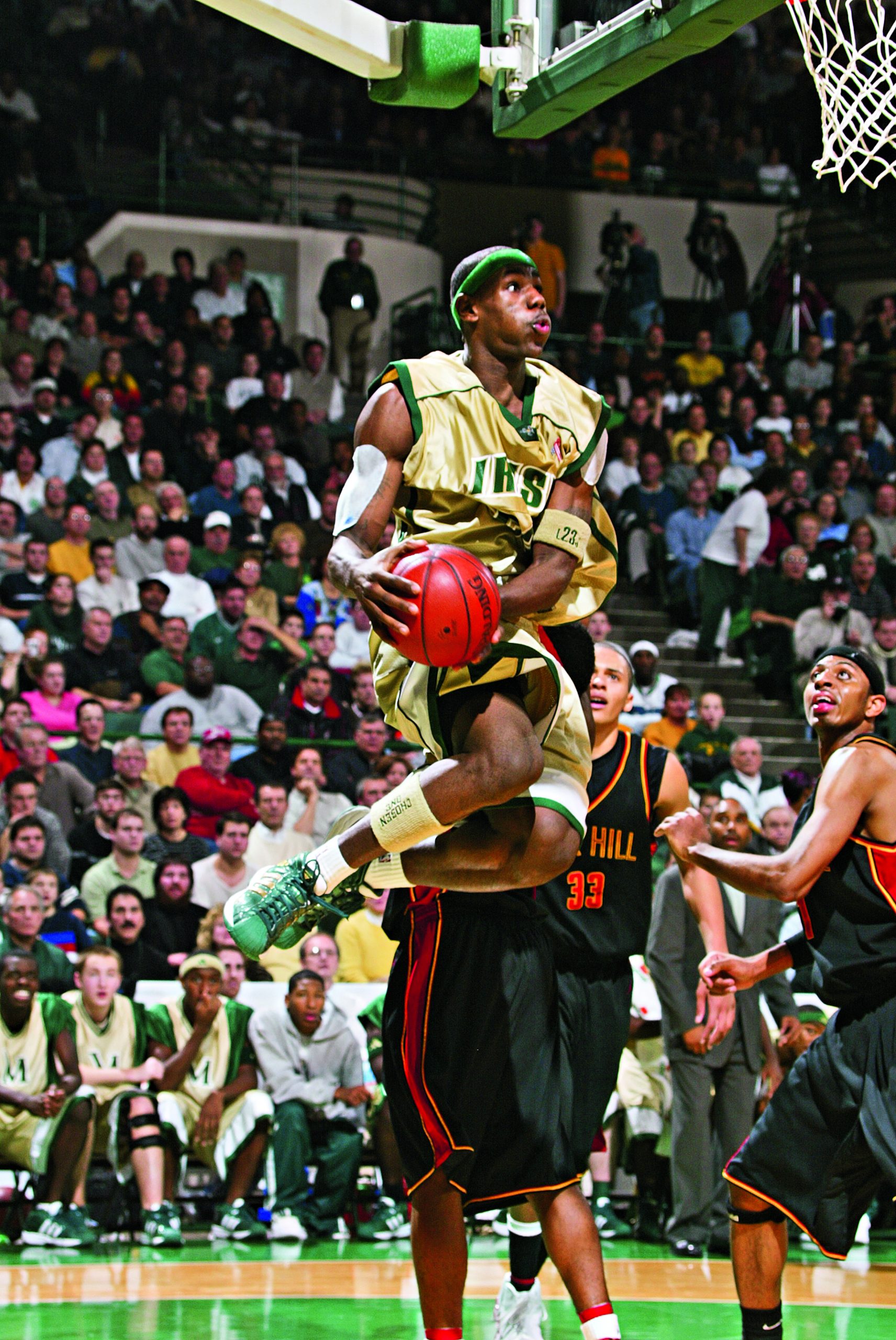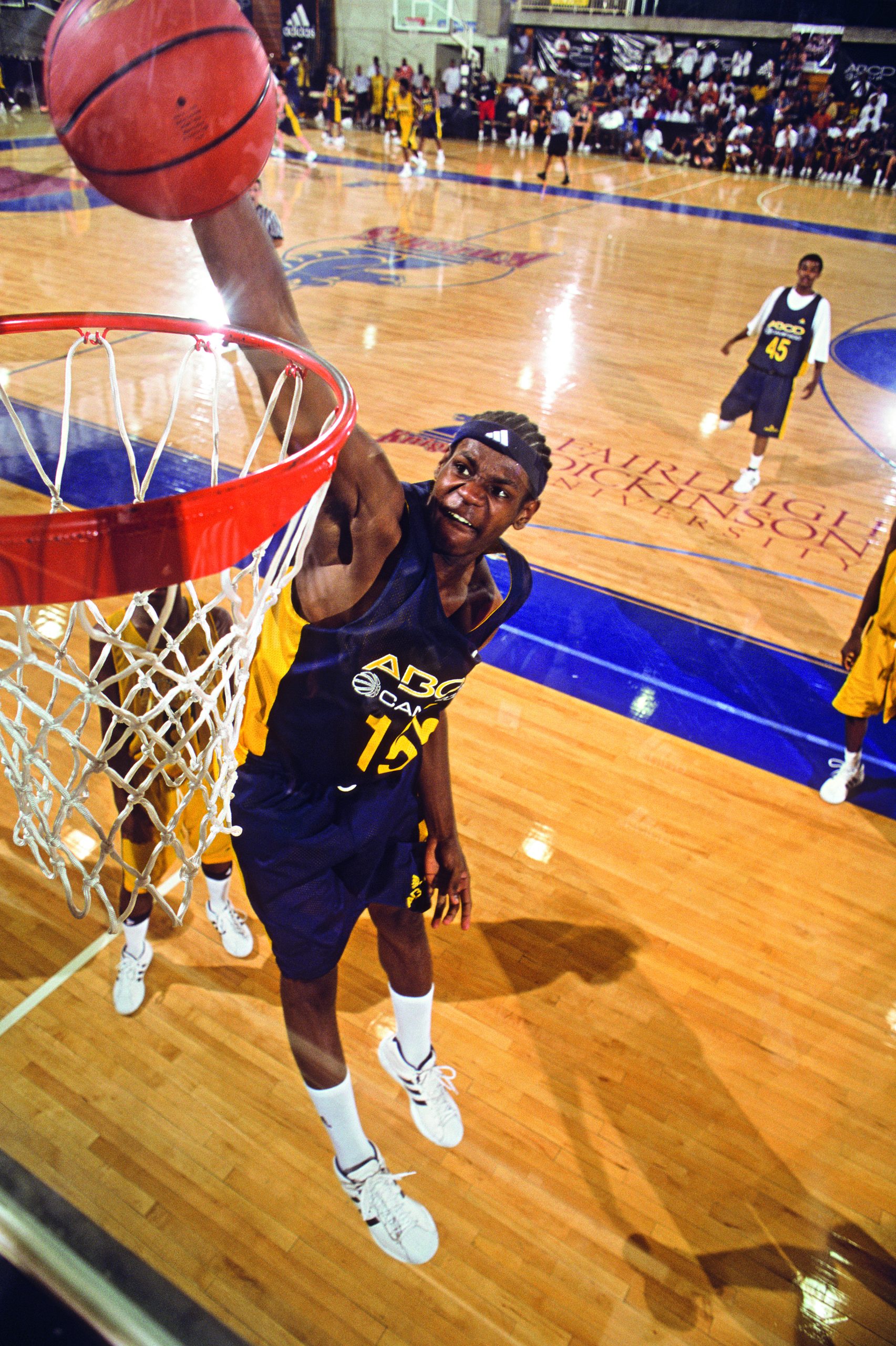Celebrating the 20th Anniversary of the ’03 NBA Draft and the Arrival of LeBron James
As we celebrate the 20th anniversary of the 2003 NBA Draft, aka the year LeBron James went pro, a former SLAM Ed. looks back at what it was like to cover a 16-year-old with a future even his wildest dreams couldn’t imagine.
In the days before YouTube and any social media platform you’ve heard of, awareness of the Next Big Thing generally came in stages. The soon-to-be multi-platinum recording artist, the future Hall of Fame athlete and the arena-headlining comedic genius almost never got famous all at once; proximity, and connections, determined who knew about them when. Fame was a gradual thing, and very few people ever had a chance to be in the select group known as “first.”
Where basketball is concerned, this publication has generally been one of the exceptions. Strictly speaking, SLAM has never discovered anyone, but we built our rep in part on introducing the game’s brightest young stars to our readers before almost anyone outside their hometowns—including our national media peers—had heard of them. We built connections across the grassroots scene, we paid attention, and in a magazine created to celebrate today’s superstars, we always found space to tell you about tomorrow’s.

There’s a compelling case to be made for LeBron James as the last true superstar to emerge from that mostly analog era, a time when magazine covers, SportsCenter highlights and at least one semi-authorized biography (more on that in a minute) did the work of building the legend. He was already one of the biggest stories in sports when he stepped onto the NBA draft stage 20 years ago this summer. A lot of that had to do with the three SLAM features, two covers and a year’s worth of Basketball Diary entries he’d already been the subject of.
Shortly before he made his NBA debut that fall, not one but two LeBron biographies hit bookstore shelves. The first of them, by about three weeks, was mine. King James: Believe the Hype exists solely because of SLAM, specifically because of the access that then 16-year-old LeBron and his tightly kept circle granted the mag before what seemed like the entire world descended on Akron to feed on, and into, the aforementioned hype. To the extent that the book holds up, it’s as a snapshot of two surreal years in the basketball life of a guy who was destined to end up on the GOAT shortlist.

Of course, LeBron was neither the first nor the last to carry the Next Big Thing weight in our pages. Founded in 1994 with a distinctly NYC lean, it was only fitting that the first prep star we aligned with was Brooklyn’s own Stephon Marbury, perhaps the last truly iconic New York City-born-and-bred hoop star. The Coney Island point god was the first person to write our Basketball Diary; four years later, when Ray Allen played a high school star based heavily on Starbury in Spike Lee’s He Got Game, his character, Jesus Shuttlesworth, got his own on-screen SLAM cover (see pg. 60 for more on that—Ed.).
The flow of hype-generating, potentially generational talent has never stopped. On LeBron’s heels, and from Marbury’s own neighborhood and bloodline, came Sebastian Telfair, who memorably shared a cover with his friend from Akron and followed him as our Diary keeper. Then came OJ Mayo, a varsity star as a West Virginia eighth grader and thus the most obvious entry into the “who’s the next LeBron?” sweepstakes that nobody needed. Understand, Bassy and OJ were incredible high school players, and maybe under different circumstances would’ve had more substantial NBA careers. As it is, they helped confirm that LeBron—the dude who somehow not only met but surpassed the most ridiculous career expectations ever put on a 16-year-old basketball player—was the exception, not the rule.
In the years since, probably only Zion Williamson and the Ball brothers have come close
to LeBron levels of pre-NBA attention with the buzz created by their hyper-viral high school highlight clips (with LaMelo and Lonzo getting an assist from Pops, of course). The latest to contend for that ultrabright spotlight is Victor Wembanyama, a true unicorn with international appeal and a highlight reel perfectly suited to TikTok and Insta edits. If you’ve been paying attention, you know SLAM was up on these dudes early and often as well.
But as this magazine approaches its 30th birthday (!!!) and the subject of this story wraps up Year 20 in the League, there still hasn’t really been a saga quite like LeBron’s.

Sometime in 2002, when the national attention and increasingly prying coverage of LeBron James became truly disruptive, the administration at St. Vincent-St. Mary High School placed a sign in front of its entrance announcing that media was not allowed on campus. But a year or so earlier, when we pulled up to campus in the spring of 2001, we were greeted with a different sign: “WELCOME SLAM MAGAZINE.”
That first visit was a chance to meet the school’s AD and basketball coaches, LeBron’s teammates and the lanky 16-year-old himself. We hung in the lunchroom, watched an informal after-school practice run, then caught dinner with LeBron and his mom. The result was the first feature-length LeBron James profile to appear outside the 330 area code. In retrospect, it seems crazy that we didn’t put him on the cover, but trust that the mere thought of putting a largely unknown high school sophomore from Ohio’s fifth-largest city on our front page seemed, at the time, infinitely crazier. SLAM in 2001 was first and foremost a newsstand magazine, and only established stars moved newsstand units. (Honestly, our biggest regret might be that one of Atiba Jefferson’s iconic shots from that story didn’t grace the cover).
Still, we were already treating him as something different. He wrote our Basketball Diary in ’01-02, becoming the first non-senior to handle the gig; a year after that initial feature, with a game-changing Sports Illustrated cover and regular SportsCenter highlights under his belt, LeBron (alongside Sebastian Telfair) landed on our cover. A year after that, with his senior year over and his unprecedented high school career behind him, he got his first solo cover. Legendary hip-hop photographer Jonathan Mannion was behind the lens; LeBron wore a Mitchell & Ness Michael Jordan NBA All-Star jersey on his chest, an acknowledgement of the expectations he welcomed, and a custom SLAM headband on his forehead. The latter was his idea, nothing we asked for or expected, a generous nod to the publication that had sought him out and told his story before anyone else.
The book came out a few months later, and much of it expanded on reporting and interviews first published in the magazine. Part of that meant acknowledging the absurdity of dedicating so much ink—a sentiment shared by the many publishers who turned down the book proposal, apparently—to an 18-year-old high schooler. My pitch—that this dude had the potential to be one of the greatest of all time—had less to do with my own scouting prowess (ha) and much more to do with the opinions of people who actually knew. That started with his high school coaches, particularly Keith Dambrot, the once- and future-Division I college coach whose reputation helped bring LeBron and a handful of his AAU teammates to St. V in the first place.
Dambrot had run offseason skills sessions at the local Jewish Community Center attended by Bron and those teammates—aka the Fab Four, which expanded to a Fab Five by the time their high school run was over—so he knew he had a talented class. It didn’t take Dambrot long to realize that in LeBron, he had much more. When we first spoke in the spring of ’01, Dambrot never hesitated in acknowledging the validity of comparisons to the likes of Magic Johnson, Kobe Bryant and Tracy McGrady. He wasn’t worried about setting up LeBron to fail against unrealistic expectations, because he saw every day how hard his best player worked, his off-the-charts basketball IQ and just how talented he was.
The rest of the world got its chance to see him as his junior and senior seasons played out. There was the legendary 2001 ABCD Camp showing shortly after his first SLAM feature—LeBron, a rising junior, outdueling top-ranked senior-to-be Lenny Cooke in a game that took on outsized significance in the trajectories of both players. Even then, LeBron was being touted (among people who didn’t read this magazine, anyway) as an “unknown” who was “discovered” at the camp. Hardly, but it was another step in the creation of a legend.

Two more steps came in showcase games against national prep power Oak Hill Academy. The first, played in Trenton, NJ, in February 2002, marked the first and only high school meeting between LeBron and Carmelo Anthony. Both players balled out, with Melo leading his stacked Oak Hill squad to the win. A year later in Cleveland, the rematch was televised by ESPN, with Bill Walton and Dick Vitale on the call. With Melo gone to Syracuse, Bron and the Irish rolled to a 20-point win.
Even the games that weren’t on ESPN were events: St. V played a national schedule during LeBron’s senior season, hooping in Philly, Los Angeles and a handful of spots in between. The team’s home games, meanwhile, were moved to the nearby University of Akron to accommodate fan interest, and a local cable company secured a deal to offer them on pay-per-view. The off-court “controversies” that came with such attention—investigations and a suspension for accepting a couple of throwback jerseys from a local store and getting an advance on a Hummer a few months before he was officially worth nine figures—were ridiculous at the time and, particularly in the NIL era, somehow look even dumber now.
And then his amateur days were over, the $90 mil check from Nike preceding the first of his many comma-heavy NBA contracts. My book came out that fall, and another…over two dozen SLAM covers have followed in the two decades since. We didn’t know how all this would turn out, of course, but being first, we could only stick around to see how it ended. Twenty years later, we’re as amazed as anyone that his story isn’t over—that somehow, there is still more to write.
Photos via Getty Images.